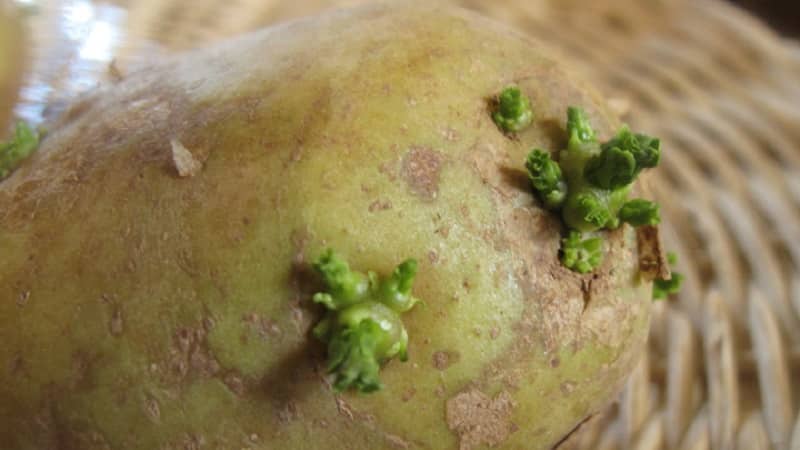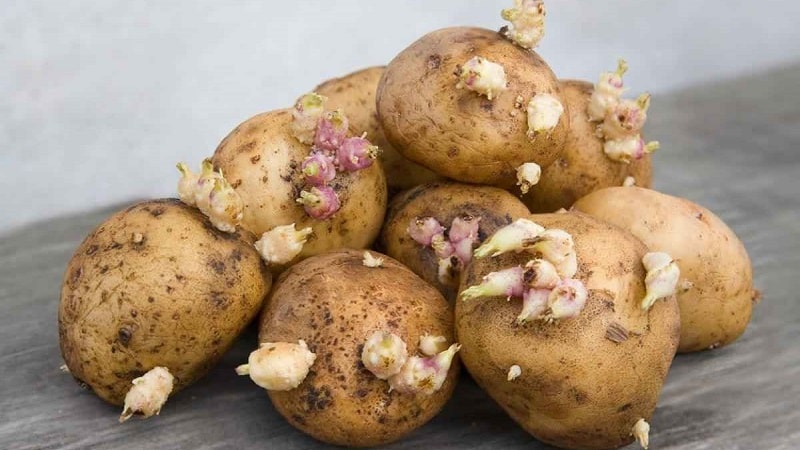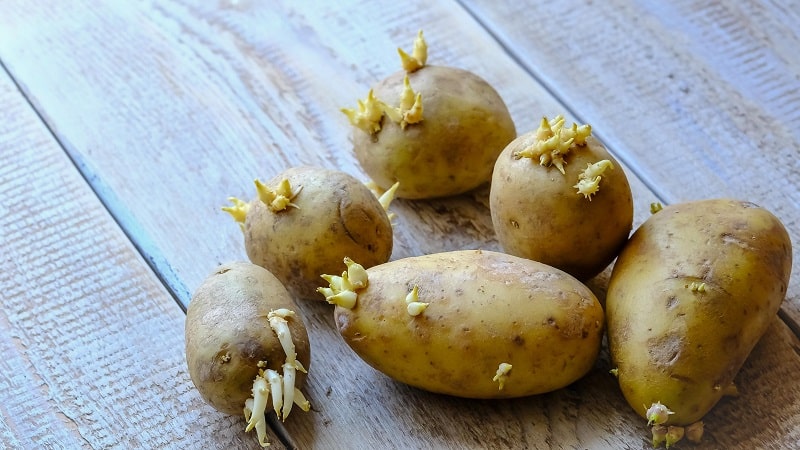Sprouted potatoes: what to do with them and can you eat them?
In the spring, all last year's potatoes germinate - this is a normal process that occurs starting in March, even if the tubers are stored in a properly equipped cellar. If you keep your harvest on the balcony or in the utility room, you will encounter this problem at the end of February.
Old tubers dry out and wrinkle, and sprouts appear on them. Just a few decades ago, no one even thought about whether it was possible to eat sprouted potatoes. In the spring, the sprouts were broken off, the thicker layer of peel was removed when peeling, and last year's harvest was eaten. No one was afraid of the potential harm; there was no information about mass poisonings from sprouted potatoes.
Now, in the wake of interest in healthy eating and changes in storage conditions, the question arises: is it possible to eat sprouted potatoes? Read on to learn how to use it correctly and in what cases you will have to throw away the remains of the old harvest.
Why are sprouted potatoes considered harmful?
Potatoes with green sides are definitely harmful.. It turns green when it comes into contact with air and sunlight due to the formation of chlorophyll. In itself, it is harmless, but under the influence of heat and light, such tubers actively produce chemicals for its further growth and development.
This natural biological process has not the most pleasant consequences for humans - solanine is released, which is poisonous in large quantities.

Why you can't eat sprouted potatoes
Closer to spring, harmful substances accumulate in tubers, and beneficial properties are lost. Store-bought potatoes begin to sprout quickly at home, but many do not throw them away, regretting the money spent or not knowing about the harm.
Whether it can be eaten depends on the number and length of the shoots. Smooth-skinned potatoes with 5-7 sprouts up to 1 cm in length can be eaten after heat treatment; the inside is not poisonous.
Take note:
Choose crumbly and tasty potatoes
Which part is the most harmful?
Toxic substances are distributed unevenly in tubers. The highest concentration is under the green areas of the peel, around the eyes and in the sprouts.
Wrinkled, soft, sprouted potatoes with long sprouts should not be eaten. Since solanine has already penetrated deep inside, removing the sprouts and cutting off the peel will not change anything. The remaining harmful substance is enough to cause poisoning.
Why solanine is dangerous
All parts of potatoes, from tops to roots, contain this substance, especially in flowers and berries.. It accumulates in tubers during storage. In autumn there is very little solanine; by February its content doubles, and in spring it reaches its highest concentration. Therefore, eating last year's potatoes in October is a direct path to poisoning.
Solanine performs a protective function for plants. It has fungicidal and insecticidal properties, increases resistance to pests and diseases. But it is toxic to animals and humans.
Red blood cells are destroyed by solanine, it is destructive to the human nervous and immune systems.
Reference. Modern potato varieties have a reduced content of this substance; it is not enough to cause serious poisoning.

Signs of solanine poisoning
When a person is poisoned with solanine, the following symptoms occur::
- lethargy;
- nausea;
- burning in the throat;
- headache;
- abdominal pain and intestinal upset;
- tremor;
- loss of orientation in space;
- elevated body temperature.
Dangerous dose of solanine for humans starts at 300 mg.
Read also:
The benefits and harms of sprouted potatoes
Potatoes that have sprouted will not cause harm if they are cooked correctly. To get poisoned, you need to eat it in large quantities raw, along with the sprouts and green skin.
Cooked old potatoes are not dangerous if you first peel them, remove eyes and sprouts, and cut off any green areas. But the benefit from such food will be small. Since in the spring the process of processing the nutrients contained in the tubers begins, the sugars, carbohydrates and vitamins needed by humans are destroyed.
Potatoes remain healthy as long as the size of the hatched sprouts does not exceed 1 cm. Microelements, carbohydrates and vitamins in such a product are available for absorption by the human body. But as soon as the size of the seedlings exceeds 2-4 cm, no useful substances remain in such a tuber, only starch.

Sprouted potatoes are used in folk medicine. In small doses, poisonous solanine can become a medicine. An alcohol tincture is prepared from the sprouts. Rub the sore spot with this remedy and make compresses.To prepare the tincture, take sprouts 5-10 cm long, wash, dry, chop and mix with alcohol or vodka.
Because solanine has an antibacterial effect, the tincture is used for treatment scratches, cuts, skin rashes. And also for diseases of the oral cavity, arthritis, high blood pressure and heart disease.
Attention! Before using alcohol tincture of sprouts, consult your doctor. Self-medication can be harmful to health.
Treatment with potato sprouts is contraindicated children under 14 years of age, pregnant women, nursing mothers and patients with diabetes.
How to properly cook old sprouted potatoes
Boiled tubers are harmless to health, you can stew them. Other cooking methods are not recommended. You cannot boil such potatoes in their skins, fry or bake them.
Since more than 90% of toxins are concentrated in the peel and pulp underneath, only 5-10% of harmful substances remain in the peeled tuber. Moreover, most of them are washed away with water. That's why After boiling the potatoes until tender or half cooked, drain the water in which they were boiled. After that, you can bake it, add it to soup, puree it, or use it as a filling for pies and dumplings.
Important! Children under 3 years old should not be given dishes made from sprouted potatoes.
Another way to use old potatoes with sprouts – as a raw material for the production of moonshine.
Use of sprouted potatoes as pet food
Cats and dogs can add potatoes to their porridge or other regular food., but not more than once a week. It is advisable to exclude this product from your pet’s diet altogether.
Important! The lethal dose of solanine for animals is from 0.6 mg per 1 kg of weight.
Potatoes are added to feed for pigs and rabbits raised for slaughter. It is prepared in the same way as for human food - the skin is peeled off in a thick layer and boiled.
Conclusion
There is no need to throw away sprouted potatoes, although they contain a high content of harmful substances. If you store potatoes correctly and cook them taking into account their biological characteristics, you do not have to worry about poisoning.
If you didn’t dare to cook a dish from sprouted potatoes, but it’s a pity to throw them away, you can benefit from them in another way - by preparing medicine or planting them in your garden.